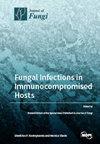揭示机制:生物营养真菌在激活或抑制植物防御反应中的作用
IF 4.2
2区 生物学
Q2 MICROBIOLOGY
引用次数: 0
摘要
本文讨论了真菌操纵植物生理机理和抑制植物防御反应的机制,真菌产生的效应物可以靶向各种宿主蛋白。效应物触发的免疫和效应物触发的易感性是植物与病原体相互作用的复杂分子对话中的关键因素。病原体产生的效应分子具有模拟病原体相关分子模式或阻碍模式识别受体结合的能力。效应分子可直接靶向核苷酸结合域、富亮氨酸重复受体,或操纵下游信号元件以抑制植物防御。在这一过程中,这些效应物与寄主植物中的受体样激酶之间的相互作用至关重要。生物营养真菌善于利用关键植物激素(包括水杨酸、茉莉酸、脱落酸和乙烯)的信号网络,与其植物宿主建立兼容的互动关系。总之,论文强调了了解植物防御机制和真菌效应物之间复杂的相互作用对于制定有效的植物病害管理策略的重要性。本文章由计算机程序翻译,如有差异,请以英文原文为准。
Uncovering the Mechanisms: The Role of Biotrophic Fungi in Activating or Suppressing Plant Defense Responses
This paper discusses the mechanisms by which fungi manipulate plant physiology and suppress plant defense responses by producing effectors that can target various host proteins. Effector-triggered immunity and effector-triggered susceptibility are pivotal elements in the complex molecular dialogue underlying plant–pathogen interactions. Pathogen-produced effector molecules possess the ability to mimic pathogen-associated molecular patterns or hinder the binding of pattern recognition receptors. Effectors can directly target nucleotide-binding domain, leucine-rich repeat receptors, or manipulate downstream signaling components to suppress plant defense. Interactions between these effectors and receptor-like kinases in host plants are critical in this process. Biotrophic fungi adeptly exploit the signaling networks of key plant hormones, including salicylic acid, jasmonic acid, abscisic acid, and ethylene, to establish a compatible interaction with their plant hosts. Overall, the paper highlights the importance of understanding the complex interplay between plant defense mechanisms and fungal effectors to develop effective strategies for plant disease management.
求助全文
通过发布文献求助,成功后即可免费获取论文全文。
去求助
来源期刊

Journal of Fungi
Medicine-Microbiology (medical)
CiteScore
6.70
自引率
14.90%
发文量
1151
审稿时长
11 weeks
期刊介绍:
Journal of Fungi (ISSN 2309-608X) is an international, peer-reviewed scientific open access journal that provides an advanced forum for studies related to pathogenic fungi, fungal biology, and all other aspects of fungal research. The journal publishes reviews, regular research papers, and communications in quarterly issues. Our aim is to encourage scientists to publish their experimental and theoretical results in as much detail as possible. Therefore, there is no restriction on paper length. Full experimental details must be provided so that the results can be reproduced.
 求助内容:
求助内容: 应助结果提醒方式:
应助结果提醒方式:


